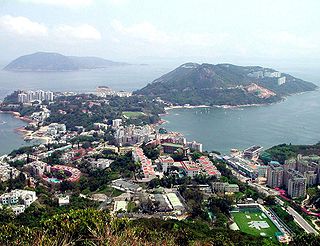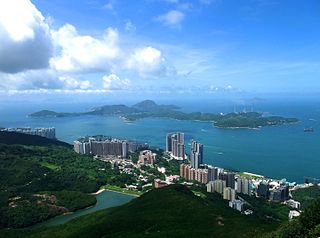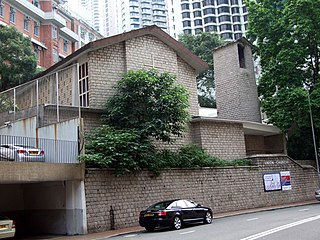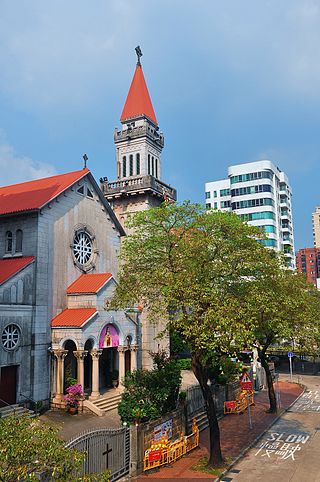
Hong Kong Island is an island in the southern part of Hong Kong. The island, known originally and on road signs simply as "Hong Kong", had a population of 1,289,500 and a population density of 16,390 per square kilometre (42,400/sq mi), as of 2023. It is the second largest island in Hong Kong, with the largest being Lantau Island. Hong Kong Island forms one of the three areas of Hong Kong, with the other two being Kowloon and the New Territories.

Stanley, or Chek Chue, is a coastal town and a popular tourist attraction in Hong Kong. It is located on a peninsula on Hong Kong Island. It is east of Repulse Bay and west of Shek O, adjacent to Chung Hom Kok and Tai Tam. Administratively, it is part of the Southern District.

Mid-Levels is an affluent residential area on Hong Kong Island in Hong Kong. It is located between Victoria Peak and Central. Residents are predominantly more affluent Hong Kong locals and expatriate professionals.

The Cathedral Church of Saint John the Evangelist is the cathedral of the Anglican Diocese of Hong Kong Island, and mother church to the Province of Hong Kong and Macao. It is the seat of the Archbishop of Hong Kong and the Bishop of Hong Kong Island.

Pok Fu Lam (薄扶林) or Pokfulam is a residential area on Hong Kong Island, at the western end of the Southern District. It is a valley between Victoria Peak and Mount Kellett, around Telegraph Bay.

The Cathedral of the Immaculate Conception is a late 19th-century English Gothic revival church that serves as the cathedral of the Roman Catholic Diocese of Hong Kong. It is located in the Mid-Levels area of the city at 16 Caine Road.

Devil's Peak is a peak in Sai Kung District, Hong Kong. The communities of Tiu Keng Leng, Lei Yue Mun and Yau Tong surround this peak.

Hong Kong China Ferry Terminal is a ferry terminal, located at China Hong Kong City, 33 Canton Road, Tsim Sha Tsui, Kowloon, Hong Kong. It is one of three cross-border ferry terminals in Hong Kong.

MacDonnell Road is a street in the Mid-Levels area of Hong Kong Island, Hong Kong.

Stanley Military Cemetery is a cemetery located near St. Stephen's Beach in Stanley, Hong Kong. Along with the larger Hong Kong Cemetery, it is one of two military cemeteries of the early colonial era, used for the burials of the members of the garrison and their families between 1841 and 1866. There were no further burials here until World War II (1939–1945).

Tao Fong Shan, officially known as To Fung Shan, is a hill with a height of 130 metres (430 ft). It is in Sha Tin, New Territories, Hong Kong. A road called To Fung Shan Road leads to the summit, where a Christian Centre can be found.

Stanley Internment Camp was a civilian internment camp in Hong Kong during the Second World War. Located in Stanley, on the southern end of Hong Kong Island, it was used by the Japanese imperial forces to hold non-Chinese enemy nationals after their victory in the Battle of Hong Kong in December 1941. About 2,800 men, women, and children were held at the non-segregated camp for 44 months from early January 1942 to August 1945 when Japanese forces surrendered. The camp area consisted of St Stephen's College and the grounds of Stanley Prison, excluding the prison itself.

Hong Kong Cemetery, formerly Hong Kong Cemetery and before that Hong Kong Colonial Cemetery, is one of the early Christian cemeteries in Hong Kong dating to its colonial era beginning in 1845. It is located beside the racecourse at Happy Valley, along with the Jewish Cemetery, Hindu Cemetery, Parsee Cemetery, St. Michael's Catholic Cemetery and the Muslim Cemetery.

Christianity has been in Hong Kong since 1841 when British Empire started to rule Hong Kong.
The Diocese of Western Kowloon is one of the three dioceses under the Hong Kong Sheng Kung Hui. Its territory covers most of western Kowloon and the western New Territories. All Saints' Church, then consecrated cathedral on 31 October 2010, was established in 1891, making it one of the oldest Anglican churches in Hong Kong. Incumbent bishop, Andrew Chan, was elected on 26 June 2011 and consecrated on 25 March 2012 to replace the outgoing bishop, Thomas Soo.
Hong Kong's Peak District was original named the "Hill District". It included Mount Austin, Mount Gough, Mount Kellett and the area around Magazine Gap. Many homes were for summer use only, to escape the heat of Central, and were referred to as "bungalows". Over time, they were given names, especially when the bungalows were rebuilt in brick or stone as substantial mansions, allowing them to better withstand the damage from typhoons.

St. Stephen's Beach is a secluded beach in the Southern District of Hong Kong, five minutes from Stanley Main Beach, and close to St. Stephen's College Preparatory School. The beach has barbecue pits. It is managed by the Leisure and Cultural Services Department and is rated as Grade 1 by the Environmental Protection Department for its water quality.

Bridges Street Market is located at No. 2 Bridges Street, at the corner of Shing Wong Street, in Sheung Wan, Hong Kong. It is a Bauhaus style market building, originally opened in 1953, and has been renovated and open in 2018 as a news museum.

Union Church is an English speaking, interdenominational church in Hong Kong, which was established in 1844. The latest Union Church building was the 4th generation building. It was located at No. 22A Kennedy Road, Mid-Levels, up the hill from Central and Admiralty, and next to where the Peak Tram bridge intersects with Kennedy Road. Demolition work started in 2017 and a residential building including a church at its base is to be built at the same location.

St. Teresa's Church is a Roman Catholic church in Kowloon Tong, Hong Kong.



















